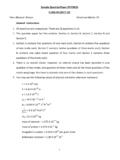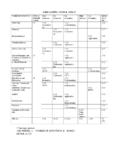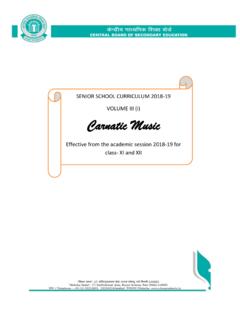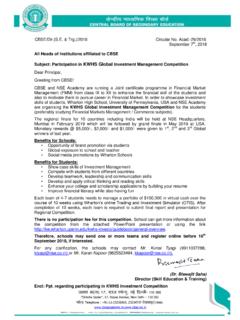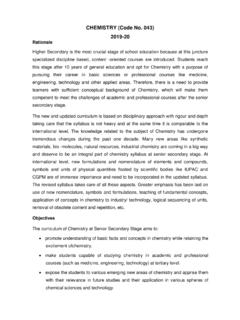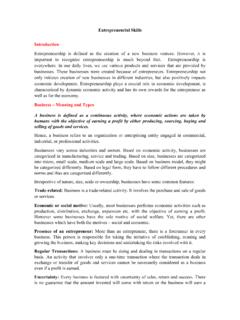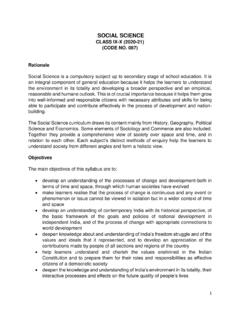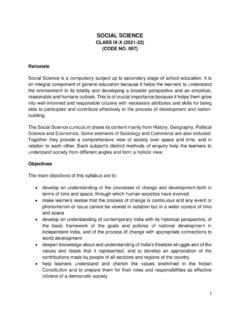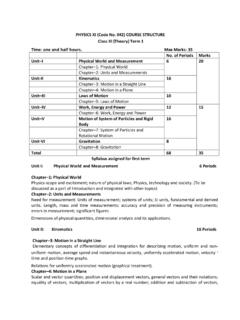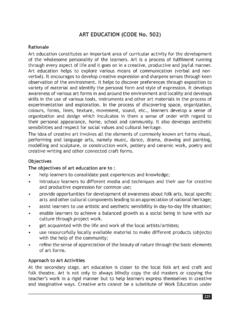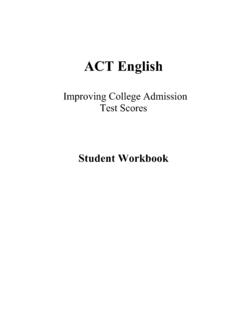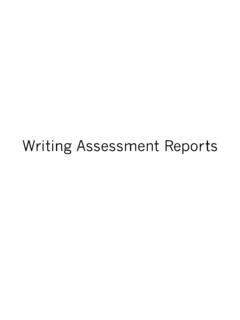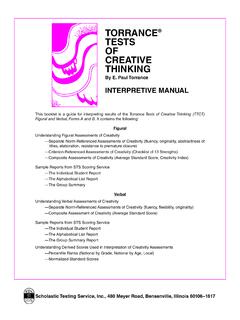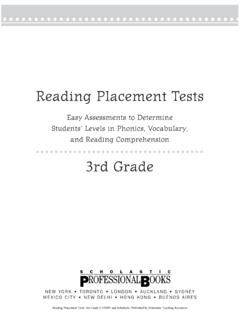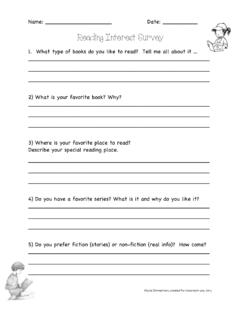Transcription of INTRODUCTION: ASSESSMENT OF SPEAKING AND …
1 INTRODUCTION: ASSESSMENT OF SPEAKING AND LISTENING SKILLS IN ENGLISH (ASL). CCE (Continuous and Comprehensive Evaluation) the flagship project of CBSE has clearly outlined the significance of SPEAKING and listening skills as part of co- scholastic areas of achievement by every learner and also stresses the clear integration of evaluation of SPEAKING and listening skills as a part of the curriculum transaction. The formative ASSESSMENT of these two skills along with other skills have been formally provisioned under CCE .But in the absence of Summative ASSESSMENT , we have not positioned the learner's proficiency in SPEAKING and Listening thereby leading to a wash back effect of very little or no importance given to SPEAKING and Listening Skills in many classrooms . As a result a large population of students passes out of schools with inadequate competence in expressive communication skills. As good communication skills raise the self esteem of a student, CBSE essentially desires that the students acquire proficiency in it by the time they leave the portals of the school.
2 In the present day global markets, SPEAKING and listening are considered to be the essential skills of real life. Since CBSE has the onerous responsibility of assessing scholastic and co- scholastic achievement levels of students in over 12000 schools affiliated to it , it has been felt for a long time that CBSE must focus on assessing SPEAKING and listening skills for qualification as Summative Evaluation as much for Formative ASSESSMENT . Considering this, CBSE proposes to give weightage in Formative and Summative assessments in ASL ( ASSESSMENT of SPEAKING and Listening Skills). This weightage is clearly specified in the 2014 curriculum document uploaded in the CBSE Academic website. Guidelines for teachers to assess SPEAKING and Listening Skills in the term-end examination: LISTENING. The Listening Comprehension section tests the candidate's ability to listen for basic interpersonal, instructional and academic purposes. A number of sub-skills need to be developed in the every day classroom transaction.
3 Given below are some of the sub-skills of listening which need to be assessed in the formative and summative assessments: i. Listening for specific information ii. Listening for general understanding iii. Predictive listening iv. Inferential listening v. Listening for pleasure vi. Intensive listening vii. Evaluative listening 1|Page Role of Assessor: An assessor is a person who is assigned the job of assessing a candidate's performance in any of the skills that is to be assessed. For the purpose of the Summative ASSESSMENT , an assessor will be a teacher who would also be an examiner or an interlocutor who will conduct the examination and do the ASSESSMENT if skills. It is extremely important to keep in mind the factors listed below as they can significantly influence the expected outcome of the Listening Test. Therefore, due care and attention must be given to each of the following: Size of the room Seating arrangements Acoustics of the room Equipment used Quality of the recording of the Listening Input Quality of the oral rendering of the Listening Input (in case it is to be read aloud by the Examiner), in terms of volume, clarity, enunciation, intonation, pace etc Test Administration: For the Assessor (Teacher).
4 1 Select the time and date of the ASSESSMENT . 2 Plan the seating arrangements in advance. 3 Decide exactly as to how much time is to be reserved for instructions or any possible interaction regarding clarifications etc and for the actual test. 4 Make the announcement giving General Instructions directed to the Candidate before the recording is played/before the reading of the text. 5 Adhere strictly to the time specified for each of the three phases of the Test (Pre-listening, While Listening and Post-Listening). 6. The general instruction given below should be followed while conducting the test. The Listening Test The Listening test comprises of a variety of task. These tasks are graded according to the length of the task and the difficulty level. Schools may download the sample tasks and reorganize them in two parts transcripts and the marking scheme for the interlocutor or the assessor and the worksheets for the students on which student swill write answers.
5 General Instructions for Students You are not allowed to ask questions or interrupt the Assessor at any point. 1 You are being tested on your Listening Skills. 2 You will hear a set of recordings of the Listening Input or listen to a reading of the Listening Input. 3 Each of the recording will be played twice. In case there is an oral rendering of the Listening Input, it shall take place twice. 2|Page 4 You are required to answer a set of questions based on each of the Listening Inputs. 5 The test consists of 4/sections. 6 You are required to attempt all 4 sections of the test. 7 Familiarize yourself with the questions on the Worksheet. It will help you to answer them later on. 8 After you have listened to the input, you will be given specified minutes to answer the questions on your worksheet 9 You may answer the questions on your Worksheet while listening. 10 Do not interact/comment until you have moved out of the Examination Room ASSESSMENT of Listening The marking key is prepared before the test is administered.
6 It will take about a period of 30-35 minutes to conduct a listening test. At the end of the test, the answer scripts should be collected and marked. It is objectives type of marking. Hence, it is suggested that scripts may be marked on the same day. SPEAKING . SPEAKING skill has acquired a very important place in the communication skills. Like listening skills a number of sub- skills of SPEAKING need to be consciously developed amongst students. Some of the sub-skills are given below which can be assessed. 1. SPEAKING intelligibly using appropriate word stress, sentence stress and intonation patterns. 2. narrating incidents and events, real or imaginary in a logical sequence. 3. presenting oral reports or summaries; making announcements clearly and confidently. 4. expressing and arguing a point of view clearly and effectively. 5. taking active part in group discussions, showing ability to express agreement or disagreement, summarising ideas, eliciting the views of others, and presenting own ideas.
7 6. expressing and responding to personal feelings, opinions and attitudes. 7. participating in spontaneous spoken discourse in familiar social situations. General Instructions 1 The total administration time for the SPEAKING test is approximately 10-12 minutes 2 The SPEAKING test will be conducted for two students at a time. 3 There will be a single teacher to function as the Interlocutor and Assessor. 4 The Interlocutor/ Assessor should be a qualified English Teacher The SPEAKING Test: Role of Assessor: 1. The (Assessor) should ensure that the room is quiet and has good acoustics. 3|Page 2. The tone, manner and body language of the Interlocutor should be relaxed, encouraging and pleasant. Care should be taken to make the candidates feel at ease. 3. Students must not be discouraged from making a fresh start in case they are unable to do so at the first attempt. 4. The Assessor needs to be flexible, sympatric and reassuring in her/his demeanour.
8 5. The Assessor should also be a proficient user of the language in order to conduct the SPEAKING test successfully. For .the interlocutor should be skilled in Elicitation techniques. For Yes/No questions should generally be avoided. 6. Alternatively questions such Explain me what you think 7. Ideally, the Assessor should award marks after the candidates have left the Examination Room. If necessary, notes can be made discreetly to be later in the scoring so that it does not make the candidates unduly tense and self-conscious. The SPEAKING test is divided into three sections as given below: I General Introduction The Interlocutor converses with the two candidates. Simple warm up questions based on the candidates' names, place of residence, leisure preferences etc are asked. II Mini Presentation In this section the Interlocutor gives each candidate the choice to pick up a Role Card or a Cue Card with a topic written on it. The candidates are given 1 minute to prepare.
9 The assessor should be ready with sheets of paper and pencil. Candidates may organize their thoughts and ideas. Prior to the day of the SPEAKING test, as an assistance to students to prepare for the presentations, a teacher can give a choice of 20 to 30 topics in class to students so that they can prepare the topics and organise their ideas on each topic .Similar topics can be given in the formal testing . Please note that candidates are not allowed to write full length answers. They may jot down points only in the sheets given by the Interlocutor. Therefore, pencil and paper should be provided on the table. Students are not allowed to carry pen, paper or mobile in the examination room. After one minute, each student will be given 2 minutes each to present his/her ideas. In case, a student is unable to speak during /for the allotted time, the (Assessor) may ask some rounding off questions. III Pair Interaction The third section of the test is for 3 minutes.
10 Both candidates are given a verbal or visual stimulus and asked to respond to it Both the candidates are given a total of 3 minutes to interact. Both of them will talk together. Closing 4|Page The closing is for 1 minute duration only. In case a student has not been able to speak or has been unable to speak owing to nervousness, the dominance of the second candidate or any other factor, then, the (interlocutor) may use the 1 minute to give a fresh opportunity to that student. Note: In the Summative II ASSESSMENT it has been proposed to record the candidates' performance in the MP 3 players/ recorders, so as to validate and make the test reliable and fair. ASSESSMENT of SPEAKING Assessors should familiarise themselves with the ASSESSMENT scale of SPEAKING . While the students are giving their presentation, assessors may refer to descriptors. It is they may share these indicators with the students while formative ASSESSMENT tasks are given. As the test will be conducted for two students at a time, it is advised that two to three teachers sit in separate rooms to conduct the ASSESSMENT of students of one section at a time.
